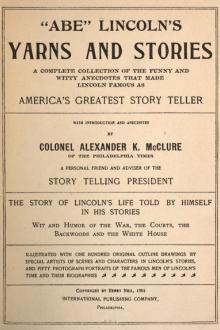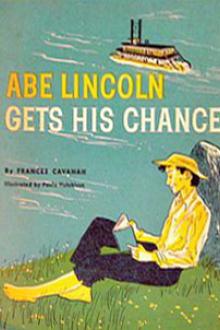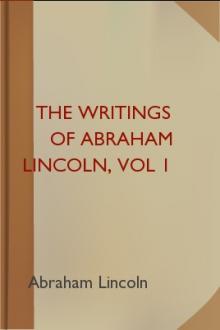''Abe'' Lincoln's Yarns and Stories, Alexander Kelly McClure [suggested reading TXT] 📗

- Author: Alexander Kelly McClure
- Performer: -
Book online «''Abe'' Lincoln's Yarns and Stories, Alexander Kelly McClure [suggested reading TXT] 📗». Author Alexander Kelly McClure
His eyes shone with the light of fever, but he was pale as death and his general appearance was haggard and unkempt. He had shaved off his mustache and his hair was closely cropped. Both he and Herold wore the uniforms of Confederate soldiers.
BOOTH SHOT BY “BOSTON” CORBETT.
The last orders given to the squad pursuing Booth were: “Don’t shoot Booth, but take him alive.” Just as Booth started to the door of the barn this order was disobeyed by a sergeant named Boston Corbett, who fired through a crevice and shot Booth in the neck. The wounded man was carried out of the barn and died four hours afterward on the grass where they had laid him. Before he died he whispered to Lieutenant Baker, “Tell mother I died for my country; I thought I did for the best.” What became of Booth’s body has always been and probably always will be a mystery. Many different stories have been told concerning his final resting place, but all that is known positively is that the body was first taken to Washington and a post-mortem examination of it held on the Monitor Montauk. On the night of April 27th it was turned over to two men who took it in a rowboat and disposed of it secretly. How they disposed of it none but themselves know and they have never told.
FATE OF THE CONSPIRATORS.
The conspiracy to assassinate the President involved altogether twenty-five people. Among the number captured and tried were David C. Herold, G. W. Atzerodt, Louis Payne, Edward Spangler, Michael O’Loughlin, Samuel Arnold, Mrs. Surratt and Dr. Samuel Mudd, a physician, who set Booth’s leg, which was sprained by his fall from the stage box. Of these Herold, Atzerodt, Payne and Mrs. Surratt were hanged. Dr. Mudd was deported to the Dry Tortugas. While there an epidemic of yellow fever broke out and he rendered such good service that he was granted a pardon and died a number of years ago in Maryland.
John Surratt, the son of the woman who was hanged, made his escape to Italy, where he became one of the Papal guards in the Vatican at Rome. His presence there was discovered by Archbishop Hughes, and, although there were no extradition laws to cover his case, the Italian Government gave him up to the United States authorities.
He had two trials. At the first the jury disagreed; the long delay before his second trial allowed him to escape by pleading the statute of limitation. Spangler and O’Loughlin were sent to the Dry Tortugas and served their time.
Ford, the owner of the theatre in which the President was assassinated, was a Southern sympathizer, and when he attempted to re-open his theatre after the great national tragedy, Secretary Stanton refused to allow it. The Government afterward bought the theatre and turned it into a National museum.
President Lincoln was buried at Springfield, and on the day of his funeral there was universal grief.
HENRY WARD BEECHER’S EULOGY.
No final words of that great life can be more fitly spoken than the eulogy pronounced by Henry Ward Beecher:
“And now the martyr is moving in triumphal march, mightier than when alive. The nation rises up at every stage of his coming. Cities and States are his pall-bearers, and the cannon speaks the hours with solemn progression. Dead, dead, dead, he yet speaketh.
“Is Washington dead? Is Hampden dead? Is any man that was ever fit to live dead? Disenthralled of flesh, risen to the unobstructed sphere where passion never comes, he begins his illimitable work. His life is now grafted upon the infinite, and will be fruitful as no earthly life can be.
“Pass on, thou that hast overcome. Ye people, behold the martyr whose blood, as so many articulate words, pleads for fidelity, for law, for liberty.”
ABRAHAM LINCOLN’S FAMILY.
Abraham Lincoln was married on November 4, 1842, to Miss Mary Todd, four sons being the issue of the union.
Robert Todd, born August 1, 1843, removed to Chicago after his father’s death, practiced law, and became wealthy; in 1881 he was appointed Secretary of War by President Garfield, and served through President Arthur’s term; was made Minister to England in 1889, and served four years; became counsel for the Pullman Palace Car Company, and succeeded to the presidency of that corporation upon the death of George M. Pullman.
Edward Baker, born March 10, 1846, died in infancy.
William Wallace, born December 21, 1850, died in the White House in February, 1862.
Thomas (known as “Tad”), born April 4, 1853, died in 1871.
Mrs. Lincoln died in her sixty-fourth year at the home of her sister, Mrs. Ninian W. Edwards, at Springfield, Illinois, in 1882. She was the daughter of Robert S. Todd, of Kentucky. Her great-uncle, John Todd, and her grandfather, Levi Todd, accompanied General George Rogers Clark to Illinois, and were present at the capture of Kaskaskia and Vincennes. In December, 1778, John Todd was appointed by Patrick Henry, Governor of Virginia, to be lieutenant of the County of Illinois, then a part of Virginia. Colonel John Todd was one of the original proprietors of the town of Lexington, Kentucky. While encamped on the site of the present city, he heard of the opening battle of the Revolution, and named his infant settlement in its honor.
Mrs. Lincoln was a proud, ambitious woman, well-educated, speaking French fluently, and familiar with the ways of the best society in Lexington, Kentucky, where she was born December 13, 1818. She was a pupil of Madame Mantelli, whose celebrated seminary in Lexington was directly opposite the residence of Henry Clay. The conversation at the seminary was carried on entirely in French.
She visited Springfield, Illinois, in 1837, remained three months and then returned to her native State. In 1839 she made Springfield her permanent home. She lived with her eldest sister, Elizabeth, wife of Ninian W. Edwards, Lincoln’s colleague in the Legislature, and it was not strange she and Lincoln should meet. Stephen A. Douglas was also a friend of the Edwards family, and a suitor for her hand, but she rejected him to accept the future President. She was one of the belles of the town.
She is thus described at the time she made her home in Springfield—1839:
“She was of the average height, weighing about a hundred and thirty pounds. She was rather compactly built, had a well rounded face, rich dark-brown hair, and bluish-gray eyes. In her bearing she was proud, but handsome and vivacious; she was a good conversationalist, using with equal fluency the French and English languages.
“When she used a pen, its point was sure to be sharp, and she wrote with wit and ability. She not only had a quick intellect but an intuitive judgment of men and their motives. Ordinarily she was affable and even charming in her manners; but when offended or antagonized she could be very bitter and sarcastic.
“In her figure and physical proportions, in education, bearing, temperament, history—in everything she was the exact reverse of Lincoln.”
That Mrs. Lincoln was very proud of her husband there is no doubt; and it is probable that she married him largely from motives of ambition. She knew Lincoln better than he knew himself; she instinctively felt that he would occupy a proud position some day, and it is a matter of record that she told Ward Lamon, her husband’s law partner, that “Mr. Lincoln will yet be President of the United States.”
Mrs. Lincoln was decidedly pro-slavery in her views, but this never disturbed Lincoln. In various ways they were unlike. Her fearless, witty, and austere nature had nothing in common with the calm, imperturbable, and simple ways of her thoughtful and absent-minded husband. She was bright and sparkling in conversation, and fit to grace any drawing-room. She well knew that to marry Lincoln meant not a life of luxury and ease, for Lincoln was not a man to accumulate wealth; but in him she saw position in society, prominence in the world, and the grandest social distinction. By that means her ambition was certainly satisfied, for nineteen years after her marriage she was “the first lady of the land,” and the mistress of the White House.
After his marriage, by dint of untiring efforts and the recognition of influential friends, the couple managed through rare frugality to move along.
In Lincoln’s struggles, both in the law and for political advancement, his wife shared his sacrifices. She was a plucky little woman, and in fact endowed with a more restless ambition than he. She was gifted with a rare insight into the motives that actuate mankind, and there is no doubt that much of Lincoln’s success was in a measure attributable to her acuteness and the stimulus of her influence.
His election to Congress within four years after their marriage afforded her extreme gratification. She loved power and prominence, and was inordinately proud of her tall and ungainly husband. She saw in him bright prospects ahead, and his every move was watched by her with the closest interest. If to other persons he seemed homely, to her he was the embodiment of noble manhood, and each succeeding day impressed upon her the wisdom of her choice of Lincoln over Douglas—if in reality she ever seriously accepted the latter’s attentions.
“Mr. Lincoln may not be as handsome a figure,” she said one day in Lincoln’s law office during her husband’s absence, when the conversation turned on Douglas, “but the people are perhaps not aware that his heart is as large as his arms are long.”
LINCOLN MONUMENT AT SPRINGFIELD.
The remains of Abraham Lincoln rest beneath a magnificent monument in Oak Ridge Cemetery, Springfield, Ill. Before they were deposited in their final resting place they were moved many times.
On May 4, 1865, all that was mortal of Abraham Lincoln was deposited in the receiving vault at the cemetery, until a tomb could be built. In 1876 thieves made an unsuccessful attempt to steal the remains. From the tomb the body of the martyred President was removed later to the monument.
A flight of iron steps, commencing about fifty yards east of the vault, ascends in a curved line to the monument, an elevation of more than fifty feet.
Excavation for this monument commenced September 9, 1869. It is built of granite, from quarries at Biddeford, Maine. The rough ashlers were shipped to Quincy, Massachusetts, where they were dressed and numbered, thence shipped to Springfield. It is 721 feet from east to west, 119 1/2 feet from north to south, and 100 feet high. The total cost is about $230,000 to May 1, 1885. All the statuary is orange-colored bronze. The whole monument was designed by Larkin G. Mead; the statuary was modeled in plaster by him in Florence, Italy, and cast by the Ames Manufacturing Company, of Chicopee, Massachusetts. A statue of Lincoln and Coat of Arms were first placed on the monument; the statue was unveiled and the monument dedicated October 15, 1874. Infantry and Naval Groups were put on in September, 1877, an Artillery Group, April 13, 1882, and a Cavalry Group, March 13, 1883.
The principal front of the monument is on the south side, the statue of Lincoln being on that side of the obelisk, over Memorial Hall. On the east side are three tablets, upon which are the letters U. S. A. To the right of that, and beginning with Virginia, we find the abbreviations of the original thirteen States. Next comes Vermont, the first state





Comments (0)